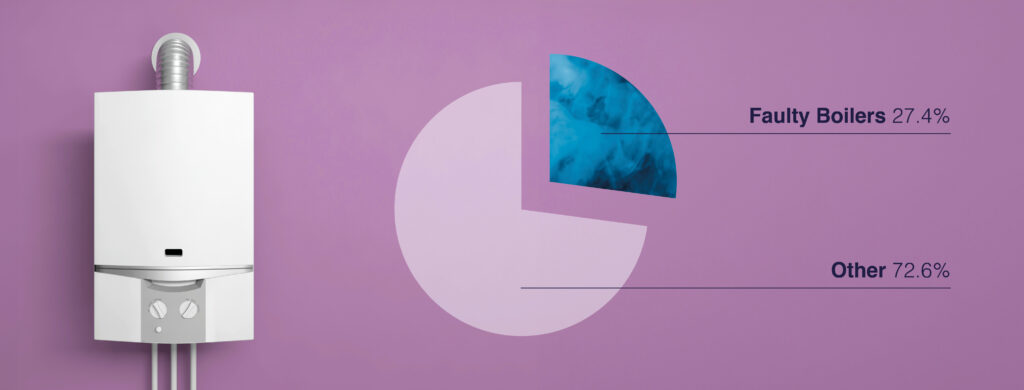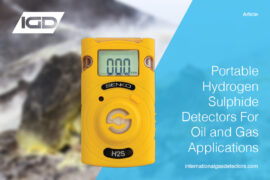Boilers are critical appliances that generate heat and power in domestic and industrial settings. However, the presence of fuel gases and the potential for gas leaks pose significant safety risks. To ensure the well-being of personnel and the integrity of equipment, effective boiler room gas detection systems are paramount.
This article outlines the importance of these systems, the types of gases they typically monitor, and the advanced technology behind their functionality. In doing so, we will explore the comprehensive solutions offered by International Gas Detectors (IGD), a trusted leader in this field.
Understanding the Significance of Boiler Room Gas Detection
While multiple case studies on boiler-related gas fatalities have been documented,1 data on gas exposure and related deaths in the UK is limited. However, the literature does reveal some important findings. For example, from 2015 to 2019, faulty boilers in the UK were implicated in 27.4% of non-fire-related CO exposure incidents in the home.2 Furthermore, between 1998 and 2019, in England and Wales, 68 fatalities were linked to CO poisoning involving a central heating boiler.3 These figures reveal how boiler room gas detection systems are more than just compliance measures; they are a fundamental component of overall safety. Such systems serve as essential safeguards, constantly monitoring for hazardous gases that could lead to fires, explosions, or health hazards. As a result, they allow for early warnings, enabling swift responses to mitigate potential dangers.

Commonly Monitored Gases
Boiler rooms can host an array of combustible and toxic gases, making a diverse gas detection system crucial. Among the gases monitored are natural gas (methane), liquefied petroleum gas (LPG), carbon monoxide (CO). Natural gas and LPG are commonly used as fuel sources, while carbon monoxide is a lethal by-product of incomplete combustion. The ability to detect these gases in real-time is essential to prevent accidents and ensure a safe environment.
Cutting-Edge Gas Detection Systems
Modern gas detection systems are built upon advanced sensor technology and sophisticated communication protocols. High-performance sensors possess a number of key performance indicators (KPIs), including acute sensitivity, high selectivity, a good limit of detection, rapid response times, a low temperature of operation, and continuous stability, to name a few.6 We are the home of addressable gas detection, offering a range of innovative solutions tailored to different boiler room setups.
For smaller installations, our TOC-635 controllers are an excellent solution. End users can quickly install these devices by following the provided guidelines. The unique 1-click automatic system setup simplifies the process, and the Sentinel+ communication platform ensures effortless sensor integration.4

IGD’s 750B series standalone gas detectors are a cost-effective and versatile option, ideal for compact boiler setups in which one or two detectors are required. These detectors feature relay outputs that can be linked to boiler control units, building management systems (BMS), or fire control systems. This integration enhances the overall safety infrastructure, enabling immediate responses in case of gas leaks.4
In larger boiler rooms, where ceiling height may be a challenge, our TOC-750S Series Aspirated detectors and gas hoods excel. These devices utilise continuous sampling, eliminating the need for engineers to work at heights when servicing the system. This not only enhances safety but also streamlines maintenance operations.4
Additionally, IGD provides portable gas detectors for boiler engineers to monitor for CO and Flammable gases. These devices are indispensable for boiler engineers working in locations without a dedicated gas detection system. The MGT 4 gas monitor provides simultaneous detection of flammable gases and carbon monoxide, ensuring engineers are not walking into unknown hazards.
Trusted Solutions from International Gas Detectors

The health and safety risks posed by boilers necessitate effective precautions. With over a century of history, IGD is a trusted provider of boiler room gas detection solutions, catering to a range of requirements from small boilers to complex industrial setups. We offer design, installation, and aftercare services. Ensuring our clients can easily establish safety systems to monitor combustible and toxic gases, through simple setup guidelines can allow for installation even without an engineer. With the implementation of IGD systems, users can be assured of ongoing environmental monitoring, providing them with a sense of security in the knowledge that their surroundings are consistently safeguarded.
References and Further Reading
- The Carbon Monoxide and Gas Safety Society. Case Studies: Fatal. Available at: https://www.co-gassafety.co.uk/case-studies/fatal/ (Accessed on 06 August 2023).
- Gentile D, et al. (2022). Carbon monoxide exposures reported to the UK National Poisons Information Service: a 4-year study. Journal of Public Health. https://doi.org/10.1093/pubmed/fdab132
- Close RM, et al. (2022). Fatal Unintentional Non-Fire Related Carbon Monoxide Poisoning: Data from Narrative Verdicts in England and Wales, 1998–2019. International Journal of Environmental Research and Public Health. https://doi.org/10.3390/ijerph19074099
- International Gas Detectors. [Online] Boiler Room Gas Detection Systems. Available at: https://www.internationalgasdetectors.com/applications/boiler-room-gas-detection/ (Accessed on 06 August 2023).
- Permentier K, et al. (2017). Carbon dioxide poisoning: a literature review of an often forgotten cause of intoxication in the emergency department. International Journal of Emergency Medicine. https://doi.org/10.1186/s12245-017-0142-y
- Ba Hashwan SS, et al. (2023). A review of piezoelectric MEMS sensors and actuators for gas detection application. Discover Nano. https://doi.org/10.1186/s11671-023-03779-8




